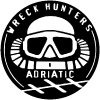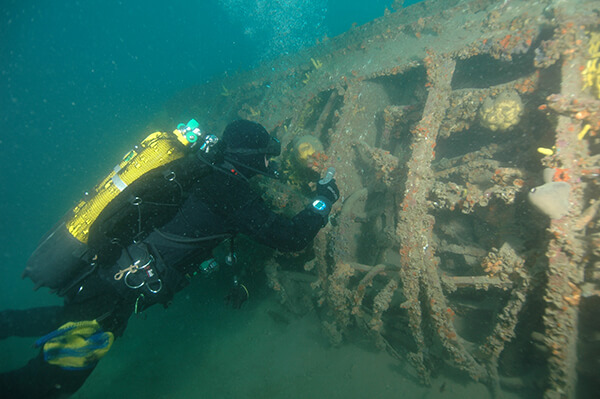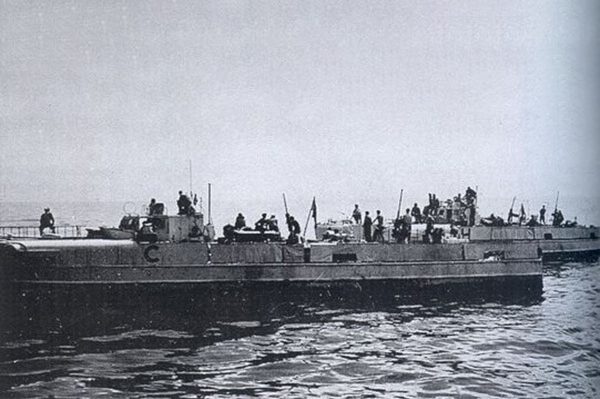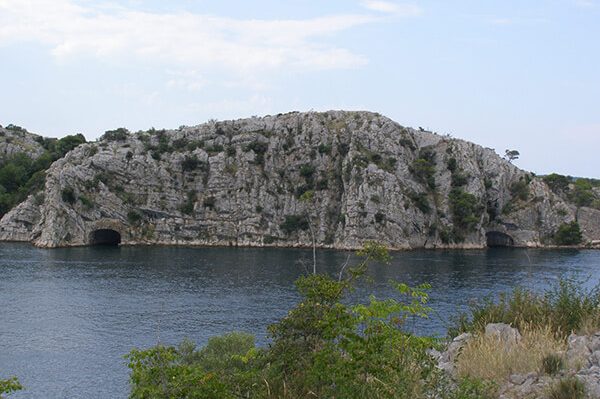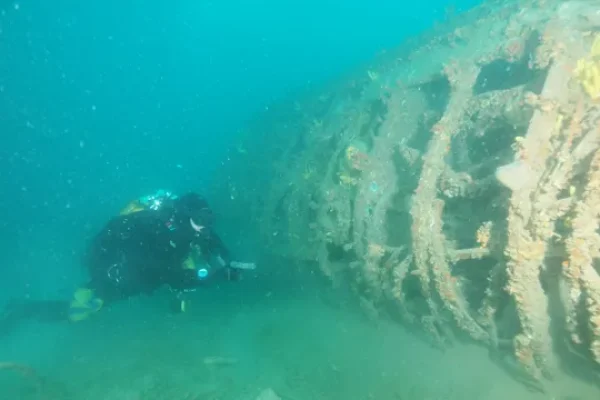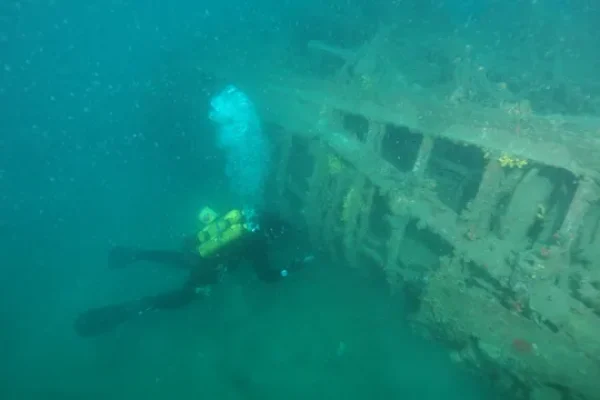SCHNELLBOOT S-158
The Schnellboot S-158 is a German torpedo boat, sunk during an Allied air attack in the St. Ante in Šibenik in 1944. It is the second Kriegsmarine torpedo boat found in the Adriatic Sea. Schnellboot S-158 was discovered undamaged and declared a protected cultural property of the Republic of Croatia in 2015. In the future, when all the conditions are met, it is planned to extract part of the movables from this wreck, their desalination, restoration and storage in the Military Museum of the Ministry of Defense, which has expressed interest in this
Author:
ZORAN DELIBAŠIĆ
Military operations of the Second World War in the Mediterranean Sea began on June 10, 1940, i.e. at the moment when Italy declared war on France and Great Britain.
Schnellboot S-158 - The secret of the Šibenik canal
Already at the end of June, France capitulated and only Great Britain with the Commonwealth countries and the Kingdom of Italy remained on the warring sides. It soon became clear that the commanders of the Italian Navy (Regia Marina) were not able to use their local supremacy over the enemy at all. Even the fact that, together with Germany, they conquered Yugoslavia and Greece in the spring of 1941 did not change the situation. The problem was that Germany, as Italy's wartime ally, did not have its own ships in the Mediterranean Sea. Therefore, in the second half of 1941, from the circles of the Directorate of Maritime Warfare of the German Navy (SKL-Seekriegsleitung Kriegsmarine), the concept of transferring its own units to the Mediterranean emerged. However, there was one big problem. The Strait of Gibraltar remained in the hands of the British, and submarines could pass through it, at best. Surface naval units were left with only the river waterways in the interior of France, which limited the size of the ships that could be sent to the Mediterranean.
A flotilla of torpedo boats
Accordingly, it was decided to transfer the 3rd Torpedo Boat Flotilla (3. Schnellbootflottille)over
France under the command of KptLt. Friedrich Kemnade and the 6th Coastal Minesweeper Flotilla (6. Räumbootsflottille) under the command of KptLt Peter Reischauer. At the beginning of the fall of 1941, the 3rd flotilla of torpedo boats began laying minefields in the waters of the island of Malta, as well as attacking British convoys. The torpedo boat base was in Sicily. With the advance of the forces of Rommel's Afrika Korps, the ships of this flotilla began to actively participate in combat activities off the coast of Africa with fluctuating fortunes of war. The American landing in French North Africa on November 8, 1942 (the operation code-named "Torch") changed the strategic situation between the adversaries, and forced the Germans to take other combat actions - escorting their own convoys, which were threatened by sea and air. On December 15, 1942, a new unit of the German Navy arrived in the Mediterranean Sea - the 7th Torpedo Boat Flotilla (7th Schnellbootflottille) under the command of KptLt. Hans Trummer. The aforementioned flotilla was founded on April 1, 1942 in Swinemünde, and it included eight of the same S-151 class torpedo boats.
Origin of the S-151 class
After the occupation of the Netherlands in May 1940, the German forces captured in the Gusto Werke shipyard in Schiedam eight unfinished torpedo boats from TM.54 to TM.61, which were built according to licensed British Power Boats for service in the Dutch colonies. German torpedo
boats took part in all the naval battlefields of Europe, and since the German shipyards could not keep up with the increasing needs of the German war machine with the dynamics of construction, it was decided to finish the construction and equipping of the captured Dutch ships. German and Dutch workers completed these ships by arming them with two torpedo launchers each for German G 7 torpedoes, caliber 533 mm, and one 20 mm gun at the stern. Due to the short hull, this class of ships did not have a 20 mm gun mounted on the bow These unique ships of British design, Dutch construction, and German armament and propulsion were modified according to the Lürssen project, which aimed to make the ships as similar as possible to the successful class of German torpedo boats S-30/100. According to the first unit in the class, the entire class received the designation S-151, and the vessels received the designations S-151 to S-158. These torpedo boats reached a top speed of 34 knots (63 km/h) and were slightly smaller and slower than the classic German torpedo boats of that era. Their length was 28.3 m, width 4.4 m, and displacement 57 GRT. The drive consisted of three reliable Daimler-Benz MB 500 diesel engines. Due to mutual visual identification, the entire class of these ships had large letters written on both sides of the ship, under the command bridge, according to the initial letter of the commander's last name or nickname. Thus, for example, the torpedo boat S-158 (former TM.61) had a capital letter "C" or "H" depending on how the commanders →
→ changed. Due to their shorter hull, they could be transported through the Raina-Rhone canals to serve the German Navy in the Mediterranean.
Operation in the Mediterranean
S-158 (commander Oblt.z.S. Claus Schultze-Jena) had its first baptism of fire during the attack on Cape Bone (Algeria), where the allied destroyers of the Force Q group were stationed. In joint action with torpedo boats S-55 (commander Oblt .z.S. Weber) and S-60 (commander Kpt. Heinz Haag) take a favorable position for the attack and on March 12, 1943 they sink the British destroyer HMS "Lightning". The primary task of the S-55 torpedo boat in that action was to lay another side minefield in addition to the minefield already laid. During that action, torpedo boats S-158, S-60 and S-55 suffered losses among their crews, with the latter two vessels having damage to their hulls and equipment. The crew of the S-158 rescued one castaway from a British destroyer. The Allied landings in Sicily (operation codenamed "Husky") began on July 10, 1943. German torpedo boats tried to act actively, but did not achieve significant success. After the Allied conquest of Sicily on August 17, 1943, the torpedo boat base was moved to Taranto and Viareggio on the west coast of Italy. A day earlier, on August 16, the 1st Torpedo Boat Division (1. Schnellbootdivision) was established under the command of FKpt. Herbert-Max Schultz,
and its composition included the 3rd and 7th flotillas of torpedo boats. It is important to emphasize that at that time the ships of the division were scattered in many places in the Mediterranean Sea, and were mostly in a bad condition due to severe wear and tear and poor supplies. On September 3, 1943, the forces of the British XIII Corps force the Strait of Messina and begin land operations on the Apennine Peninsula. Failures in military operations forced the Italian government to renew talks with the Allies about a cease-fire, and the decision was made at the beginning of July 1943, and on August 8, 1943, it finally came into force. The capitulation of Italy caused great confusion among the Italian soldiers, as well as the former allies of the Germans. The landing of the American 5th Army in the Tyrrhenian Sea in the Gulf of Salerno (operation code-named "Avalanche") lasted from September 9 to 16, 1943, and during that time part of the ships of the 1st Torpedo Boat Division were in the ports of the Tyrrhenian Sea. On the night of September 10-11, 1943, torpedo boats S-151, S-152 and S-158 attacked the Allied shipping in the Gulf of Salerno from Civitavecchia. The fired torpedoes caught up with the American destroyer U.S.S. Rowan (DD – 405) which, hit in the ammunition compartment, sank in less than 40 seconds with most of the crew. Only 72 castaways were saved, and 202 crew members died. The actions taken in the following days in the Salerno area did not result in any success, which was
equally contributed to by the tenacious resistance of the Allies and the poor technical condition of the few working torpedo boats. To describe the state of the fleet, it is enough to say that at that time there were four torpedo boats from the 3rd and 7th Flotillas in Toulon (France) that were not ready for combat, and the other two ships from the 7th Torpedo Boat Flotilla remained in Viareggio. During the idle time in the ports, through experience gained in battle, the installation of armor plates to protect vital parts of equipment and personnel was started, as well as the additional arming of ships with anti-aircraft gun mounts on all operational torpedo boats. The main base of the 7th Torpedo Boat Flotilla at the beginning of November 1943 was located in Marseille (France). In such circumstances, it is not surprising that the Supreme Command of the German Navy decided at the end of October 1943 to withdraw torpedo boats from the western part of the Mediterranean, ie the Ligurian Sea, and transfer them to the Adriatic or the Aegean Sea. The implementation of this, although logical, but still rather complicated operation, which involved transporting the ships by rail to Piacenza, and then sailing the Po River to the Adriatic, turned out to be more difficult than initially planned. Due to the deepening of the riverbed, the operation lasted more than four months. Finally, arriving from the western to the eastern side of the Apennine peninsula to Venice, these navigational units →
→ were reassembled and qualified for navigation. At the beginning of March 1944, a total of 11 torpedo boats arrived in the calmer waters of the Adriatic, which primarily needed to be repaired. This was then followed in the Venetian Arsenal and the Breda shipyard.
Arrival of the 7th flotilla of
torpedo boats to the Adriatic
The headquarters of the 1st Torpedo Boat Division on the Adriatic Sea was in Venice. The division was under the direct command of Admiral Jadran, and included vessels from the 3rd, 7th and 24th torpedo boat flotillas. Most of their vessels were out of order or outside the Adriatic. At the end of May 1944, the base of the 7th Torpedo Boat Flotilla became Split with an average of five working torpedo boats, while the Germans still had an average of only two to three vessels of the 3rd Torpedo Boat Flotilla, which were based in Boka Kotorska, and Dubrovnik. The ships of the 7th Torpedo Boat Flotilla in the Adriatic were initially focused on anti-partisan actions in coastal waters and disrupting allied supplies in southern Italian ports. After the partisan and allied units introduced a new battle strategy in the form of landing raids from their stronghold on Vis in the direction of the island under German control, on April 22, 1944, the ships of the 3rd and 7th Torpedo Boat Flotillas were ordered to focus their operations between the islands of Korčula and Vis.
Among the skirmishes with the partisan forces of the 7th Torpedo Boat Flotilla, the most famous are the participation of the ship S-158 (together with three twin ships from the 7th Flotilla) in the capture of several partisan transport ships near Cape Ploča. During two nights, on May 31 and June 1, 1944, several motor ships with more than 200 partisans, wounded and civilians were captured. The established pattern of transferring prisoners to the decks of their ships followed, and enemy shipping units were sunk by placing explosive charges The following night, June 2, 1944, a group of torpedo boats on patrol (S-155 and S-156) southwest of the islet of Blitvenica intercepted the armed ship NB 8 Kornat. In a sequence of unfortunate war circumstances and surprises on both sides, the partisan ship fought a battle with a superior enemy, first with two, and later with a total of four torpedo boats (S-153 and S-157 also arrived) on the course towards Vis. In that conflict, the partisans captured one German sailor, damaged two torpedo boats, and wounded several German sailors along with nine of their own fighters. Also, the available literature describes the sinking of the partisan PČ 73 "Pionir" near Drašnice on the night of September 14-15, 1944, in which torpedo boats S-152, S-154 and S-158 participated. On a night patrol on October 9, 1944, S-158 captures the crew of a partisan sailboat and sinks it with explosives. With the growth of the Allied military superiority, not only in the air but
also at sea, the tasks also become escorting long-shore convoys, ie supplying coastal garrisons exclusively at night. In the second half of 1944, the overloading of boats and men with combat operations increased, as well as the growing needs of the land army for supplies in the coastal garrisons. The main reason for this was the increasing activity of the partisans, who daily threatened the supply of troops on the coast by demolishing roads and railway installations. The Torpedo Boats of the 7th Torpedo Boat Flotilla also engaged in several naval engagements with British Light Marines equipped with Torpedo Boats (MTB) and Motor Gunboats (MGB) in which they were not without a chance of success. On the contrary, the propulsion of the ships on diesel fuel (in contrast to the petrol used by the British), the discipline, training and hardened crews were their main trump cards. However, the change in the fortunes of war on all fronts, in the long run, could not end positively for the German Navy. Nevertheless, the ships of the 7th Torpedo Boat Flotilla on the night of July 23-24, 1944, in the naval battle near Cape Lovište, severely damaged the British MTB 372, which was sunk by British aircraft the next day. During the patrolling of four torpedo boats (S-153, S-155, S-156 and S-157) on the night of June 11-12, 1944, northwest of the island of Hvar, they encountered two British destroyers, which met them with open fire from →
→ the S-153 (commander Olt. Sven Rautenberg) with 17 crew members. The unsuccessful escorting of the old torpedo boat TA 34 (formerly T7) handed over to the NDH Navy on 24 June 1944 by the torpedo boats of the 7th Flotilla (S-154 and S-157) represents an illustrative disaster to which larger and slower vessels were exposed. The torpedo boat with its escort was intercepted near the islet of Kukuljari by ships of the British Light Naval Forces, and stranded on the island of Murter, it was destroyed by cannon fire. In the last months of the war, these ships often carried out joint actions with naval commandos from the so-called Marine – Einsatz – Kommandos (MEK). Due to the lack of personnel, on October 13, 1944, the reorganization of the 1st division of torpedo boats in the Adriatic was carried out, withdrawing the previous 3rd and 7th flotillas, to which the 24th torpedo boat flotilla was added on October 25. The 3rd Flotilla of Torpedo Boats was newly founded, and it consisted of units of the former 3rd Flotilla which since then belonged to the 1st Group (Oblt.z.S. Backhaus), the 7th Flotilla to the 2nd Group (Oblt.z.S. Buschmann), and the ships of the 24. flotillas made up the 3rd group (Oblt. Bollenhagen) 3rd flotilla of torpedo boats. Its former commander (Kptlt. Günther Schulz) remained at the head of the 3rd Torpedo Boat Flotilla. For the Germans, torpedo boats were the most important combat naval units on the eastern coast of the Adriatic in the conditions of Allied military superiority at sea and in the air. This was especially
evident in the conditions of using increasingly modern radar devices where, even with the indented coast of the eastern Adriatic, the larger naval units of the German Navy had no chance for a long life. Only the torpedo boats, thanks to their basic armament, could keep the large Allied shipping units out of the inter-island area where all German shipping took place. Given that they had no real targets for their torpedoes in the eastern Adriatic, it can be said that their most important function was to deter larger ships from attacking communications and harbors in German hands. Precisely because of this, the loss of every torpedo boat, permanently or temporarily, represented a particularly heavy blow for the German Navy.
"Autumn storm" in Dalmatia
After Bulgaria's withdrawal from the war, i.e. its transfer to the side of the Allies, the balance of power in the eastern part of the Balkan battlefield changed critically. German Army Group Southeast ("E") in Greece was in danger of being isolated and destroyed. On October 5, 1944, the commander of the Southeast informed the 2nd Panzer Army (2nd OA) that, due to the danger of the withdrawal of German forces from Greece, he proposed to the Supreme Command of the Armed Forces (and they translated this into an order on 10 October 1944) to the 2nd OA the experienced 118th fighter and 264th infantry divisions withdraw from the Adriatic coast
due to stopping the penetration of the Red Army from the east. It was also proposed (and later ordered) that the main battle front should be the line: Rijeka - Senj - Velebit ridge - Knin - Livno - Mostar - Nevesinje. Then the defense of that line should be taken over by the 392nd, 373rd and 369th legionary divisions, and strongholds should be organized on the most vulnerable parts of the coast. The new line of defense was given the name "green" (Grün), and the withdrawal maneuver from the Adriatic coast was codenamed "Herbstgewitter" (autumn storm). In connection with the movement of the main line of defense from the coast inland, the German Navy was tasked with evacuating material important for the conduct of the war, preferably by sea, in the direction of Rijeka and Trieste, and what could not be retrieved was to be destroyed. Naval combat and transport assets had the task of withdrawing to the area of the northern Adriatic. Mobile coastal battleships were to be placed under the control of land army units, stationary ones were to be destroyed, and naval rifle battalions were to be formed from their personnel. Ultimately, it was necessary to destroy all ports, wharves, walled shores, harbor facilities and breakwaters, as well as industrial plants and all facilities of military importance. According to the order of the headquarters of the 264th Infantry Division, the units of the 891st Regiment and parts of the Navy were to be transferred from Zadar to Šibenik, and then to Knin by land. Given →
→ that the 19th Partisan Division had cut the road Zadar - Knin, it was decided that the retreat to Šibenik would be carried out by ships. For this purpose, all available forces of the German Navy, which were in Šibenik at that moment, were engaged and that stage of withdrawal was successfully completed without losses. On October 22, 1944, an order was issued to disband the torpedo boat stronghold in Šibenik. The plan was to evacuate all assets, ships and personnel of the stronghold. Last in the withdrawal plan were the manpower and equipment for maintaining radio communication. In that time period, 7 torpedo boats were still stationed in Šibenik with many transport ships and other units that were waiting for the organization of the convoy and the movement towards the ports of northern Dalmatia, Istria. Due to the lack of anti-aircraft defense with strong firepower, at the end of 1944, the Allied air force made merciless attacks from low altitudes on all concentrations of ships and port facilities. In this way, almost the entire German maritime freight traffic was blocked, which, in addition to the insufficient capacity of its own ship space, was almost completely disabled. With a certain passage of time, the logical consequence of this in the entire German Navy was a decline in combat morale as well as the quality of human personnel after five difficult years of warfare. In the War Diary, the Admiral of the Jadran repeatedly pointed out the constant losses of ships in the main transshipment ports on the Dalmatian coast due to the lack of
efficient anti-aircraft defense. Of course, the port of Šibenik was no exception.
Sinking of S-158 in Šibenik
Šibenik's port, apart from being spacious, due to the relatively low coast, provided almost no conditions for high-quality camouflage of ships, with the exception of the narrow area of the Sv. Ante. Due to the protection of smaller shipping units from air bombardment, primarily torpedo boats, German engineering units began to build a trench for ships, which they did not manage to finish during their stay in Šibenik. The tunnel is excavated in the vertical rock of the eastern side of the canal, at the foot of the Lobor hill, and has two entrance-exit openings. Allegedly, the construction was completed by German prisoners of war in the post-war period. For some time, they were used by the post-war Yugoslav Navy to hide Higgins-type torpedo boats built under an American license in the Korčula shipyard in the 1950s. However, due to its small dimensions, the mine soon became unpromising and was abandoned from active military use. Today, it is known among the local population as "Hitler's eyes" and is one of the tourist attractions of the city of Šibenik. During preparations for the withdrawal of German forces from Šibenik and its surroundings (operation codenamed "Wikinger"), on October 25, 1944, in the aerial bombardment of German ships on the camouflaged mooring in the channel of Sv. Ante
torpedo boat S-158 was hit by Allied aircraft. She was tied up and masked on the west side of the northern entrance to the canal and received a direct hit by an aerial bomb in the bow. From that hit, the ship sank with the bow while the stern remained vertically raised above the surface of the sea. Two German sailors were killed in this attack, six were wounded, including the commander of the ship StOb-Strm. Hertwig. Torpedo boat S-156 was also damaged at that time on the camouflage mooring but did not sink. After the Harbor Master from Šibenik (KptKo. Otto G. Kulavitz) issued an order to remove all moving essential spare parts from the sinking ship, such as propellers, and to save all confidential documents from the ship, the final sinking of the ship was planned by activating an explosive loading on October 27, 1944. A day earlier, on October 26, 1944, at 2:20 p.m., parallel to the arrival of a higher tide in the channel, the wreck of the ship S-158 overturned and completely sank. The port of Šibenik did not have adequate diving equipment for underwater searches in search of confidential documents and maps. The prevention headquarters took measures to destroy the wreck of the ship under water by exploding a depth charge bomb, which was done on October 27, 1944. Thus, the wreck lay undiscovered for almost 70 years. According to the Annals of the Monastery of St. Lovre in Šibenik and the war diary of Admiral Jadran, the aerial bombardment of the ships on the camouflage mooring in the channel took place →
→ around 11:20 a.m. on the specified day by 6 allied twin-engine aircraft. The war diary even states that it was an attack by a Mosquito type bomber. However, according to precise information obtained from aviation enthusiasts from Zagreb, it was determined that 6 PV-1 Ventura twin-engine bombers of the South African Air Force from the 25th squadron (Squadron No. 25 SAAF) participated in the attack. The mentioned squadron operated as part of the Balkan Air Force (BAF) from May 1944 to July 1945. The attack on the ships in the canal was supposed to be carried out with rockets from Beaufighter-type aircraft, but as the photo-reconnaissance flight revealed only light anti-aircraft defenses, a burst of Venturas was sent to bombard them with aerial bombs. After the attack, the Mosquito PR XVI photo-reconnaissance aircraft made a sortie, confirming that one ship was on fire in the canal. Of the remains of the 2nd group of the 3rd torpedo boat flotilla, the S-154, was sunk in the Allied bombardment of the port of Pula on January 22, 1945, and the S-157, was sunk in the Gulf of Trieste on May 1, 1945, by partisan mortar fire. The rest of the group saw the end of the war by escaping from the partisans and surrendering to the Allies on May 3, 1945 in the port of Ancona, namely S-151, S-152, S-155, S-156.
Discovery of the wreck
In mid-June 2014, on the occasion of the reconnaissance of part of the middle Adriatic, organized by the Department of Underwater Archeology at the Croatian Restoration Institute
(HRZ) and the Zagreb diving club ZG-SUB (today's Wreck Hunters Adriatic), it was decided to inspect one potential site in the channel St. Ante in Šibenik. Namely, the auther of this article found a photo of the sinking of the German torpedo boat S-158 on the Internet, with which he introduced Igor Miholejek, head of the aforementioned HRZ Department, who expressed interest in it. It is a black-and-white photograph taken at the time of the sinking of the ship, where the location can be determined by the villa (today the villa is called "My Peace"), which is located in the background of the sinking ship at the very entrance to the Šibenik canal. Since consulting various sources about the possible recovery of the wreck from the sea in the post-war period did not indicate such a scenario, we decided to verify the fact of its (non)existence on the spot. The Department obtained a license from the Port Authority of the city of Šibenik for diving on the waterway, and logistical support was provided by the company Jadranski ronilački servis from Šibenik. After the dive plan was made orianting according to the contours of the environment from the mentioned archival photo, the team was divided into two diving pairs. In the first dive, after only a few minutes, the first diving pair found and marked the position of the wreck and thus enabled the second pair to dive directly to the find without wasting time and make the first photo and video documentation of this sunken ship. Five weeks later, more precisely on the weekend of July 26-27, 2014, the same organization, but this time reinforced by the team of the Military Museum of the Ministry
of Defense, carried out investigative dives on the underwater wreck of the torpedo boat S-158, as well as the media presentation of the find in question. In this way, archaeologists, divers and museum workers located the wreck and together revived the story of this relatively long-ago war event from the Second World War. The peculiarity of this find is ambiguous, primarily due to the intactness of the wreck itself in the period of 70 years since its destruction. The reason for this probably lies in the fact that it is located in the middle of the waterway of the Šibenik Canal, i.e. in the part where activities such as sports and recreational diving are prohibited. This fact, that it is located right on the waterway, will unfortunately prevent any further tourism valorization of the wreck. The significance of the find also lies in the fact that this is only the second torpedo boat of the German Navy found in the sea of the Republic of Croatia (along with the S-57 near Žuljana, which has been known for more than four decades and has been declared a protected cultural property of the Republic of Croatia). The very location of the sunken ship, almost in the heart of the city of Šibenik, which can rightly be considered the cradle of underwater archeology on the eastern side of the Adriatic, was a surprise to experts and the general public. Finally, the very method of discovering the wreck according to the archival photograph of the sinking of the ship is a unique case in underwater archeology in this area.
Wreck condition
The shipwreck lies at a depth of 38 meters and →
→ is positioned in a north-south direction on a slope that falls to a maximum depth of 45 meters in the middle of the channel. The aft part of the ship is facing the exit of the channel in the direction towards the open sea, and the part with the damaged bow is facing the center of the city of Šibenik. The shipwreck is missing the bow in its entirety because that part was hit by an aerial bomb, but the other two thirds of the ship are very well preserved. Ships of this type, including this torpedo boat, were built of wood with a metal lattice structure. As a result of the aggressive action of sea water, the mahogany collapsed, so that the ribs of the ship and the metal structure of the superstructure remained visible. Investigative diving around the ship found numerous items that belonged to the torpedo boat, such as the inventory of the ship's galley, weapons, ammunition, as well as two torpedo heads and the ship's external compass on its stand. All this indicates that this wreck was truly discovered for the first time, not
only officially, because if it were not so, these objects would surely have already disappeared from the seabed. The wreck itself, on the upper and right side, is covered with a large seine net (tunar), which we assume was caught in an attempt to prevent the escape of the JRM ships in September 1991 by blocking the channel by fishermen from Tribunj and Šibenik. The transparency of the sea, and thus the visibility in the channel, is usually poor because it is the course of the Krka River in the part where it mixes with the sea, so it becomes brackish, as well as due to the large amount of suspension of silt particles triggered by heavy rainfall during the summer months in 2014.
Protection and conservation
The Croatian AF underwater archeology department sent a request to the Conservation Department in Šibenik to initiate the protection of the site, and ultimately to declare the wreck a cultural asset. After
the official procedure, the site was declared a cultural asset of the Republic of Croatia, and diving is officially prohibited. Of course, that will not be the end of the story, since the said Department, in cooperation with the Military Museum of the Ministry of Defense, plans to conduct additional research and filming in order to reveal all the circumstances of the sinking. These activities marked the beginning of the first collaboration between the Military Museum of the MOD and underwater archaeologists from the CAF. In the near future, when all the conditions are met, the plan is to extract part of the movables from this wreck and their desalination, restoration and storage in the Military Museum of the Ministry of Defense, which has expressed interest in it, all with the aim of making the objects from the German torpedo boat once brought closer to the eyes of the public after the necessary processing and displayed in a museum display.


